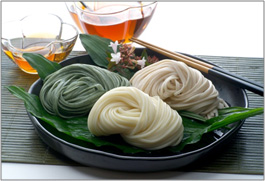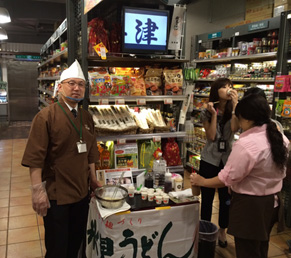Reports and Statistics
Challenge! International Business - Firm, Smooth Texture Key to Tasty Himi Udon: Kaizuya, Co., Ltd.
Winning contracts through sample tastings
August 2014
"No matter what it takes, there can be no compromise on the taste of udon" - such a belief is embodied in Himi Udon, which is now being received favorably by high-end restaurants primarily in Asia, and the number of export destinations keeps rising steadily. Frozen noodles have been developed in recent years. It is encouraging to see them address this challenge with a positive attitude.

Himi Udon comes in a variety of thicknesses and forms
Picture in the center: thin udon,
left: yomogi (mugwort) udon,
right: ancient-style rice udon

Elastic texture of the noodles as a selling point is achieved by an experienced Udon maker kneading the dough repeatedly.
Preserving the hand-made process
Himi City, famous for winter yellowtail called Himi kan-buri is located in the north-west part of Toyama, at the base on the east side of the Noto Peninsula. It is one of three major production areas in Japan of hand-stretched udon called Himi Udon. Kaizuya was established in 1975 with a view to spreading this type of udon throughout Japan. While adhering to the traditional production method that has been passed down without interruption, the company exercised its own ingenuity in stabilizing production.
One of the selling points of Himi Udon is that you can enjoy both the noodle's firm, sticky texture and smooth feeling when it passes through the throat. This feature comes from a repeated process of kneading dough made from flour and salted water similar to the teuchi (hand-kneading) technique by master udon makers. This is a product of a rare process of incorporating a teuchi element into the tenobe (hand-stretching) process.
The company places a highest priority on the taste of noodles. In addition to caring about the original flavor of the wheat, it insists on using only natural ingredients. The noodles are free from coloring, preservatives and additives. The process of hand-kneading is not mechanized, and no oil is used in the stretching process in order to bring out the natural flavor. This seemingly cumbersome process helps Himi Udon preserve the original flavor of the wheat.
As a matter of fact, I (writer) am from Kagawa, famous for producing Sanuki Udon. Understandably, I am a big lover of udon. When I was transferred to Toyama and ate Himi Udon for the first time, I was surprised by the smooth feeling when the noodles passed down the throat. Compared to Sanuki Udon, featuring thick noodles with a feeling of fullness after eating, Himi Udon is easy to eat and has a delicate taste that seems to be enhanced by the thinness and whiteness of the noodles. The main products of Kaizuya are thin noodles, and they are in high demand as gifts, such as midsummer gifts and year-end gifts. In addition, they have become recognized nationwide by word of mouth as popular food products that can be delivered to household. Now, the company is aiming at developing the overseas market in order to popularize their Udon.
The best way is to have people taste the noodles
At overseas business meetings, the company emphasizes having participants taste the products. "Once they taste our products, they will understand the delicious taste of our udon", says Kentaro Kaizu, managing director. The reason for serving cold udon at sample tastings is to allow people to experience the strong elasticity of the noodles. A soup broth made from white prawns, which is a local specialty of Toyama, is served to raise the profile of the characteristics of Toyama.
In November 2010, the company participated in business meetings with overseas buyers held in Singapore. What prompted the company to participate in the meetings was an invitation from a bank with which they have transactions. Although it was the first time to participate in the overseas business meetings, eventually the company received business offers from several companies. Anticipating a certain reaction, the company was ready for another visit to Singapore for the purpose of following up with clients. Then, the Great East Japan Earthquake struck Japan, and all business was cancelled. The environment for exports of Japanese food products took a rapid downhill turn, and the company was placed in a situation where it had no opportunities to make business deals. However, the managing director visited Singapore as originally planned and vigorously carried out sales activities through local trading firms. This led to the conclusion of a deal with a grand chef of the creative Asian cuisine restaurant at Marina Bay Sands. The key to success was of course a sample tasting event. The chef tasted Himi Udon, and an order was placed right away. According to the managing director, "That our noodles are free of food additives may have matched the demands from the health-conscious, high-end customers who choose good quality products even if they are expensive". He thought he could finally saw a glimmer of hope just as his company was facing the loss of all potential clients. "I was about to give up advancing into the overseas market unless I closed this business deal", recalls the managing director.
Since then, he has been visiting various parts of the world, more than 10 times a year. As the number of export destinations increased, an overseas business coordinator joined him, and the number of personnel at the company increased. In August 2013, Kaizuya participated in the 2013 JETRO Food Export Business Meeting in Toyama, where they met a buyer from Thailand and felt confident that a deal would be concluded. JETRO Toyama invited the buyer from Thailand again for follow-up negotiations, and they concluded a deal. This prompted Kaizuya to participate in an exhibition held in Bangkok in May 2014. The company is likely to strike a deal with several companies that visited the exhibition. This exhibition was organized and held by the above-mentioned Thai buyer.
In the last four years since 2010, Kaizuya has developed sales channels in high-end restaurants and groceries in Singapore, Kuala Lumpur, Bangkok and Hong Kong. Small export volumes aside, what is the reason behind the success of this fast-paced overseas market development over such a short term? According to the managing director, "It was a result of the continued effort to go to these places to do business". Visiting buyers periodically and accompanying the buyers on visits to their customers and having direct communications with them often makes a favorable impression on the customers. The sales style of working together with the buyer led to a successful conclusion of a business deal. The managing director says, "The utmost requirement for sealing a deal is the perseverance and determination to never give up on the sales representative despite sudden problems and obstacles".

Having people taste and recognize the taste through sample tasting
Issues that have been raised in business negotiations
In the course of the business negotiations, some issues were raised. It was found that when using the noodles in restaurants, dried noodles takes a lot more time to boil. Fortunately, Kaizuya had just developed frozen Himi Udon using the sharp freezer to overcome this weak point. Thanks to the frozen version, the boil time could be shortened from 24 minutes for dried noodles to only two minutes. Of course, there was no difference in tastes between the dried and frozen versions. Moreover, the frozen noodles have an advantage over the dried ones: cooking the dried noodles can generate uneven boiling, but in case boiling the frozen noodles, such unevenness does not occur because they are boiled in advance. However, expensive transportation costs will become a new concern.
Currently, the major export destinations are Asian countries. It just happens that in Asia, restaurants, including noodle specialty shops that cater to genuine-conscious consumers, are on the rise, and the company is sure that there will be considerable demand there. On the other hand, market research was carried out in the U.S., which is the biggest export destination of noodles, including udon, soba, and somen, and the company is evaluating the feasibility of cultivating the market in the U.S. The expectations of the managing director are growing. Kaizu says, "Eventually, I want to spread the taste of Himi Udon all over the world, starting from U.S. and Asia, then to the West, to Dubai, Russia and Europe. I want people around the world to taste delicious Japanese udon, in particular our udon with its sticky but elastic texture".
Making Himi Udon the udon of the world...The challenge for the company in realizing this dream continues.
Yusuke Nagao
JETRO Toyama
Kaizuya, Co., Ltd.
Foundation: 1975
Representative Director: Kenji Kaizu
Capital: 10 million yen
Location: 20 Kamiizumi, Himi-shi, Toyama
Business description: Sales of Himi Udon (noodles), restaurant management (udon shop)
Number of employees: 20
Webpage: http://www.kaizuya.co.jp/



